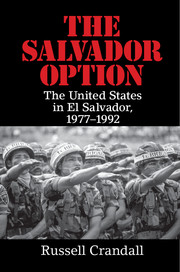Book contents
- Frontmatter
- Dedication
- Epigraph
- Contents
- List of Figures
- List of Organizations
- Acknowledgments
- 1 Introduction
- PART ONE EL SALVADOR IN THE COLD WAR
- PART TWO JIMMY CARTER
- PART THREE RONALD REAGAN
- 19 Reagan Arrives
- 20 Reagan and Salvador
- 21 El Mozote
- 22 Another Vietnam
- 23 Solidarity
- 24 Troop Cap and Certifying Human Rights
- 25 Reagan Gambles on Elections, 1982
- 26 The Shultz Doctrine
- 27 Human Rights
- 28 Henry Kissinger
- 29 Contras
- 30 “Elections Yes, Dialogue No,” 1984 Presidential Election
- 31 La Palma
- 32 Esquipulas
- 33 Counterinsurgency I
- 34 Counterinsurgency II
- 35 Zona Rosa
- 36 Air War
- 37 José Napoleón Duarte
- 38 Iran-Contra
- PART FOUR GEORGE H. W. BUSH
- PART FIVE POSTWAR
- Notes
- Bibliography
- Index
29 - Contras
from PART THREE - RONALD REAGAN
Published online by Cambridge University Press: 05 June 2016
- Frontmatter
- Dedication
- Epigraph
- Contents
- List of Figures
- List of Organizations
- Acknowledgments
- 1 Introduction
- PART ONE EL SALVADOR IN THE COLD WAR
- PART TWO JIMMY CARTER
- PART THREE RONALD REAGAN
- 19 Reagan Arrives
- 20 Reagan and Salvador
- 21 El Mozote
- 22 Another Vietnam
- 23 Solidarity
- 24 Troop Cap and Certifying Human Rights
- 25 Reagan Gambles on Elections, 1982
- 26 The Shultz Doctrine
- 27 Human Rights
- 28 Henry Kissinger
- 29 Contras
- 30 “Elections Yes, Dialogue No,” 1984 Presidential Election
- 31 La Palma
- 32 Esquipulas
- 33 Counterinsurgency I
- 34 Counterinsurgency II
- 35 Zona Rosa
- 36 Air War
- 37 José Napoleón Duarte
- 38 Iran-Contra
- PART FOUR GEORGE H. W. BUSH
- PART FIVE POSTWAR
- Notes
- Bibliography
- Index
Summary
So, I guess in a way [the Nicaraguan rebels] are counterrevolutionaries, and God bless them for being that way. I guess that makes them contras and so it makes me a contra, too.
– President Ronald Reagan, March 14, 1986A “Disorderly Mix of Policies”
The last time we touched on Nicaragua, we left off with a Carter administration whose attempts at influencing the new Sandinista government entailed direct U.S. development assistance amounting to $118 million by January 1981. In spite of these attempts, it became clear via intelligence reports that Nicaragua's goals for a “revolution without frontiers” had not abated. Now it was Ronald Reagan's turn to check perceived communist expansion in the hemisphere. Reagan's administration watched as Managua began courting the global left. After signing a “party-to-party” deal with the Soviet Union, Nicaragua began accepting shiploads of weaponry from Cuba, North Korea, Czechoslovakia, and the Soviet Union. But for the Reagan administration and even some Democratic members of Congress, the Sandinistas’ continued arms shipments to the FMLN in El Salvador would become the major sore point.
In the summer of 1981, Assistant Secretary of State for Latin America Thomas Enders met with Sandinista leader Daniel Ortega in an attempt to reach a deal that would end Nicaragua's military assistance to El Salvador. Ortega became defensive against Enders's seemingly imperialist tone, adding that the Sandinistas had no intention of ceasing arms shipments to El Salvador. Ortega continued to his U.S. counterpart that Managua had “decided to defend our revolution by force of arms…and to take the war to the whole of Central America if that is the consequence.”
Later that year, Reagan approved National Security Decision Directive 17 (NSDD 17), signaling a robust new attentiveness to the region, including an intent “to assist in defeating the insurgency in El Salvador, and to oppose actions by Cuba, Nicaragua, or others to introduce…supplies for insurgents.” The plan continued the Carter-era support of “democratic forces” in Nicaragua, but it also provided for the military training of indigenous units and leaders both in and out of the country who opposed the Sandinista government. Under NSDD 17, Enders embraced the ongoing covert preparations to arm and train anti-Sandinista fighters, presenting them as “a lowball option, a small operation not intended to overthrow.
- Type
- Chapter
- Information
- The Salvador OptionThe United States in El Salvador, 1977–1992, pp. 306 - 316Publisher: Cambridge University PressPrint publication year: 2016

